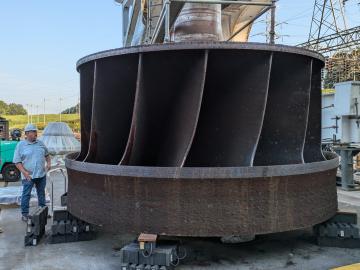
Filter News
Area of Research
- Advanced Manufacturing (19)
- Biology and Environment (18)
- Building Technologies (1)
- Computational Biology (1)
- Computational Engineering (1)
- Energy Science (68)
- Fusion and Fission (4)
- Fusion Energy (7)
- Isotopes (2)
- Materials (36)
- Materials for Computing (7)
- National Security (3)
- Neutron Science (10)
- Nuclear Science and Technology (12)
- Nuclear Systems Modeling, Simulation and Validation (1)
- Supercomputing (17)
News Type
News Topics
- (-) 3-D Printing/Advanced Manufacturing (93)
- (-) Advanced Reactors (27)
- (-) Biomedical (32)
- (-) Composites (25)
- (-) Hydropower (6)
- (-) Molten Salt (8)
- (-) Polymers (24)
- Artificial Intelligence (62)
- Big Data (34)
- Bioenergy (46)
- Biology (51)
- Biotechnology (16)
- Buildings (43)
- Chemical Sciences (57)
- Clean Water (16)
- Computer Science (121)
- Coronavirus (28)
- Critical Materials (23)
- Cybersecurity (21)
- Education (3)
- Element Discovery (1)
- Emergency (2)
- Energy Storage (80)
- Environment (99)
- Exascale Computing (24)
- Fossil Energy (2)
- Frontier (25)
- Fusion (28)
- Grid (43)
- High-Performance Computing (58)
- Irradiation (3)
- Isotopes (29)
- ITER (6)
- Machine Learning (31)
- Materials (107)
- Materials Science (94)
- Mathematics (3)
- Mercury (5)
- Microelectronics (1)
- Microscopy (31)
- Nanotechnology (44)
- National Security (26)
- Neutron Science (88)
- Nuclear Energy (55)
- Partnerships (36)
- Physics (31)
- Quantum Computing (21)
- Quantum Science (47)
- Security (13)
- Simulation (24)
- Software (1)
- Space Exploration (13)
- Statistics (2)
- Summit (32)
- Transportation (73)
Media Contacts

A team of researchers used the Frontier supercomputer and a new methodology for conducting a genome-wide association study to earn a finalist nomination for the Association for Computing Machinery’s 2024 Gordon Bell Prize for outstanding

Oak Ridge National Laboratory researchers are using a new bioderived material to 3D print custom roosting structures for endangered bats.

Researchers have developed and 3D printed the lightest crack-free alloy capable of operating without melting at temperatures above 2,400 degrees Fahrenheit, which could enable additively manufactured turbine blades to better handle extreme temperatures, reducing the carbon footprint of gas turbine engines such as those used in airplanes.

ORNL researchers were honored with a prestigious ACE Award for Composites Excellence by the American Composites Manufacturers Association. The team won the “innovation in green composites design” prize for creating a fully recyclable, lightweight wind turbine blade tip that incorporates low-cost carbon fiber and conductive coating for enhanced protection against lightning strikes.

Researchers at ORNL are using advanced manufacturing techniques to revitalize the domestic production of very large metal parts that weigh at least 10,000 pounds each and are necessary for a variety of industries, including energy.

Justin West, an advanced machining and machine tool researcher at ORNL, has been selected as a recipient of the 2024 30 Under 30 award by the Society of Manufacturing Engineers.

A study led by the Department of Energy’s Oak Ridge National Laboratory details how artificial intelligence researchers created an AI model to help identify new alloys used as shielding for housing fusion applications components in a nuclear reactor. The findings mark a major step towards improving nuclear fusion facilities.

A team led by scientists at ORNL identified and demonstrated a method to process a plant-based material called nanocellulose that reduced energy needs by a whopping 21%, using simulations on the lab’s supercomputers and follow-on analysis.

ORNL is working with industry partners to develop a technique that combines 3D printing and conventional machining to produce large metal parts for energy applications. The project, known as Rapid Research on Universal Near Net Shape Fabrication Strategies for Expedited Runner Systems, or Rapid RUNNERS, recently received $15 million in funding from DOE.

Researchers for the first time documented the specific chemistry dynamics and structure of high-temperature liquid uranium trichloride salt, a potential nuclear fuel source for next-generation reactors.


